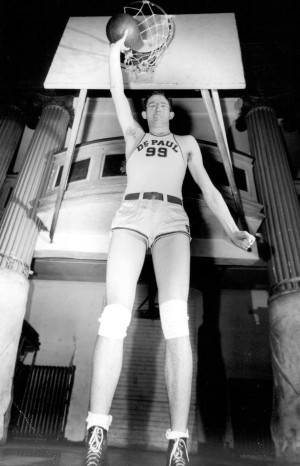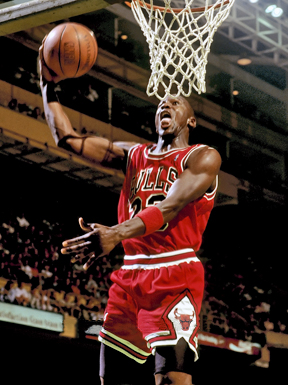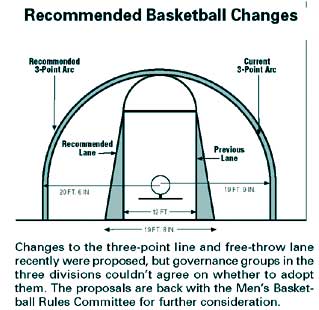In 1891, a physical education teacher in Springfield, Massachusetts invented the game we would come to know as basketball. In setting the height of the baskets, he inadvertently created a design problem that would not be resolved for decades to come.

As James Naismith tacked up a pair of peach baskets at either end of the school gym, he did not give much thought to how high. He simply nailed them up 10 feet above the ground, split the students into teams, gave them an old soccer ball, and told the kids to try and score points by getting the ball in the opposing team’s basket.
As the game became more popular, super-tall players began to dominate the sport. In the 1940s and 1950s, dunking was still rare, but critics were already concerned that it was too easy to score.

Then, in the 1960s, slam dunks started to take off. They were a captivating shot that reinforced the role of the so-called “big man” on the courts.
There was a political dimension to all of this as well. The dunk was becoming popular at a turbulent time in the country. The Black Panthers were organizing and arming themselves in Oakland and some white Americans were worried a revolution was about to take place. The rise of dunking was seen by some racist critics as a literal manifestation of “Black Power,” embodied in masters of the dunk like Lew Alcindor, who would later change his name to Kareem Abdul-Jabbar.
Under pressure from critics of the dunk, the NCAA (National Collegiate Athletic Association) made a decision to ban the dunk in 1967. The NBA (National Basketball Association) did not ban the dunk, but still faced criticism about the slowness of play in the league.

That’s because, with or without the dunk, the game was just too jammed up around the net. Players would huddle around the basket and hand the ball to their “big man” teammates to score. Everyone involved seemed to share the sense that something needed to change.
People suggested a lot of fixes to make the game more dynamic: no backboard, a convex backboard, a smaller basket, a bigger ball, a smaller ball, a no scoring zone around the basket, and even a height cap, which would work like a sports team salary cap but using a player’s height instead of wages.

None of those changes caught on, but a rival professional basketball league, new to the scene, came along aiming to shake things up with some other fresh approaches. The ABA (American Basketball Association) had many crazy ideas, including half-time shows with bear wrestling. Most of their ideas didn’t stick. Except for one: the three-point shot.

Originally, shots from the field were worth two points. But the ABA’s innovation was to draw an arced line, about 22 feet from the basket. Any shot made from behind that line was now worth three points.
Fans loved the three-point shot. It was impressive, but it was also something fans could practice at home. It was a shot they could aspire to.
The three-point shot also critically changed the dynamic on the court, rewarding attempts from further out and breaking up the cluster around the net. In turn, this reduced reliance on taller players, giving other players chance to shine.
In 1976, the NBA and the ABA merged. Two years later, they added the three-point shot. Instead of designing the beautiful, powerful dunk out of the game, they designed a counterbalance. And now the game is more inclusive than it ever has been. There is room for little guys as well as big guys, and the latter are even shooting three-pointers now. Players are having to evolve just like basketball has evolved.
Some traditionalists still see the three-point shot as a problem (and they still don’t like the dunk, for that matter) but a lot of things that have had to change since James Naismith tacked those peach baskets to the gym wall. And to think: all of this started with a more-or-less accidental decision by a PE teacher just trying to keep kids quiet, entertained, and out of trouble.



Comments (9)
Share
Read the Plaque: http://readtheplaque.com/plaque/larry-legend-bird-33-
Great episode, but why was a single basket made to be worth 2 and not 1 point?
Last night in Bozeman: 25 3’s
Changing the game – just like the podcast highlighted.
http://espn.go.com/video/clip?id=14764460
I love the show. This episode however is incredibly poorly researched. The popularity of basketball and the 3 point line have very little to do with each other. Basketball regained popularity because of the dynamic personalities and skills of Magic, Bird, Dr. J, and the greatest of all Jordan. The effects of the 3pointer and its usage in the current game are unknown. If anything the dunk saved the game. Dr. J and Jordan made it art. The Bird Magic rivalry saved the game. The sheer physical brilliance of LeBron are the reason for the games popularity. Not the 3 point line. We will know the effects of the current game 10 years from now.
You might be hearing from a lot of Canadians on this one, James Naismith is one of our heroes, I mean a Canadian who invented one of Americas games! But sadly, it was not mentioned that Naismith was a Canadian working in the US.. I’m sad now..:(
If you are going to talk about 3 point shots, you have to bring up Oscar Schmidt and the 87 gold medal the US lost in Indianapolis.
If you are going to talk about three-point shots, you have to talk about Oscar Schmidt and the gold medal the US lost at home in 87. I was a kid then but I remember that was the first time the importance of the three-point shots were made clear to me. What a match!
Naismith had lots of good ideas. The second one was taking the bottom out of the peach basket so they didn’t have to haul a ladder out to get the ball back in play. Whoever came up with reversing the play after every basket was another important gain.
Dear 99% Invisible crew,
Brilliant and excellent episode as always! The only thing with which I was disappointed was the omission of the fact that James Naismith was a Canadian.
So many of the acknowledged heroes in the world are American, and I believe that the rest of the world should have a chance to celebrate our inventors, designers, and role models. Every country shows its brilliance, and every architect (of buildings or LEGOs) needs to know that their country can shine just as bright as any other.
It is a small thing, but by giving a three-second nod to another country besides the United States, it shows future entrepreneurs and beautiful nerds that there is more to the world than the U.S., and that one need not be strictly American to be relevant.